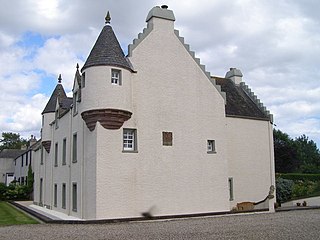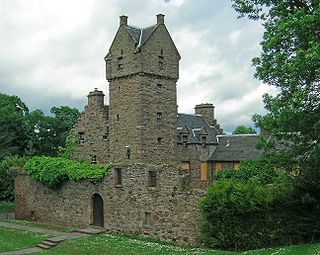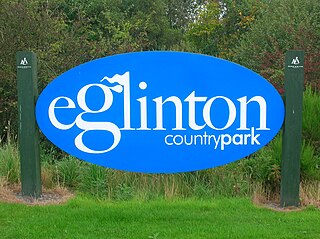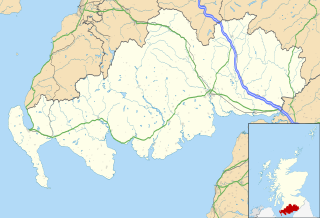Citations
Coordinates: 54°51′23″N4°59′48″W / 54.8565°N 4.9968°W
| This article about a Scottish castle is a stub. You can help Wikipedia by expanding it. |
Garthland Castle was a castle that was located near Garthland Mains, Dumfries and Galloway, Scotland. [1]
The castle was possibly built in 1211, as a datestone bearing that date has been discovered within the Garthland Mains estate. It would appear that further extensions in 1274 were undertaken, as another datestone has been reused within the Garthland Mains estate. The castle was seat of the family of M'Dowall of Garthland.
Coordinates: 54°51′23″N4°59′48″W / 54.8565°N 4.9968°W
| This article about a Scottish castle is a stub. You can help Wikipedia by expanding it. |

Lochwinnoch is a village in the council area and historic county of Renfrewshire in the west central Lowlands of Scotland. Lying on the banks of Castle Semple Loch and the River Calder, Lochwinnoch is chiefly a residential dormitory village serving nearby urban centres such as Glasgow and Paisley. Its population in 2001 was 2628.

Drongan, a former mining village, is situated on the western edge of Ayrshire, some 8 miles from Ayr and 8 miles from Cumnock and has a population of 3,205 approx.
Silverknowes is a district of Edinburgh, Scotland. Silverknowes lies to the northwest of the city. The district contains over 2000 homes, ranging in size from bungalow to semi-detached housing, much of it built during the mid-twentieth century.

Davidson's Mains is a former village which is now a district in the north west of Edinburgh, Scotland. It is adjacent to the districts of Barnton, Cramond, Silverknowes, Blackhall and Corbiehill/House O'Hill.

Craigmillar, from the Gaelic Creag Maol Ard, meaning 'High Bare Rock', is an area of Edinburgh, Scotland, about 3 miles (4.8 km) south east of the city centre, with Duddingston to the north and Newcraighall to the east.

Monboddo House is a historically famous mansion in The Mearns, Scotland. The structure was generally associated with the Burnett of Leys family. The property itself was owned by the Barclay family from the 13th century, at which time a tower house structure was erected. In 1593, the Laird was James Strachan, and thence it passed into the Irvine family and thereafter the Burnetts of Leys. There is a notable datestone adornment on the structure with the arms of Irvine impaling the arms of Douglas with initials R.E. and I.E. and dated 1635, representing the 17th-century couple who reconstructed the house, Robert Ervine (sic) and Ilizabeth Ervine (sic). Monboddo House, with its crow-stepped gable design, is situated in the Howe of Mearns near the village of Auchenblae approximately nine miles (14 km) from the North Sea. The original landholding of the Monboddo Estate was approximately 200 km².
The Crom Estate is a nature reserve located in the south of County Fermanagh, Northern Ireland, along the shores of Upper Lough Erne. It is one of three estates owned and managed by the National Trust in County Fermanagh, the others being Florence Court and Castle Coole mansions. The estate comprises 1,350 acres (5.5 km2), composed primarily of riparian forest. Some trees are so ancient that physical access is restricted.

Balnagown Castle is located beside the village of Kildary in Easter Ross, part of the Highland area of Scotland. There has been a castle on the site since the 14th century, although the present building was remodelled in the 18th and 19th centuries. Balnagown is the ancestral home of the Chiefs of Clan Ross, although since the 1970s it has been owned by the Egyptian-born businessman Mohamed Al-Fayed. The castle is protected as a category B listed building, and the grounds are included on the Inventory of Gardens and Designed Landscapes in Scotland, the national listing of significant gardens.
Portlethen Village is a settlement along the North Sea coast in Aberdeenshire, Scotland. The village is also known as Old Portlethen. The skerry of Craigmaroinn is situated just off the coastline near Portlethen Village.

Clan MacDowall is a Lowlands Scottish clan.

Mains Castle is a 16th-century castle in Dundee, Scotland. The castle consists of several buildings surrounding a courtyard, although several of the original western buildings no longer exist. The northern and eastern buildings are where the family would have lived, with the servants occupying the southern quarters. The castle also has a large, six-floor, square tower house with dressed cornerstones, which is typical of 16th-century construction. It is a Category A listed building.

Castle Leslie Estate, home to an Irish branch of Clan Leslie and located on the 4 km², Castle Leslie is both the name of a historic Country House and 1,000-acre Estate adjacent to the village of Glaslough, 11 km (7 mi) north-east of Monaghan town in County Monaghan, Ireland.

Eglinton Country Park is located in the grounds of the old Eglinton Castle estate, Kilwinning, North Ayrshire, Scotland. Eglinton Park is situated in the parish of Kilwinning, part of the former district of Cunninghame, and covers an area of 400 ha. The central iconic feature of the country park is the ruined Eglinton Castle, once home to the Eglinton family and later the Montgomeries, Earls of Eglinton and chiefs of the Clan Montgomery. Eglinton Country Park is managed and maintained by North Ayrshire Council and its Ranger Service.

Castle Semple is a former mansion house located in Renfrewshire, Scotland. It is situated near the eastern end of Castle Semple Loch, within Clyde Muirshiel Regional Park.

Stoneykirk is an area and a village in the heart of the Rhins of Galloway, Wigtownshire, in the administrative council area of Dumfries and Galloway, Scotland nearly ten miles in length and three and a half miles in breadth, bounded on the east by the bay of Luce, and on the west by the Irish Channel, 5 miles (8.0 km) south of Stranraer.

The Douglases of Mains are a branch of the Clan Douglas, related to the Lords of Douglas through Archibald I, Lord of Douglas. The first Laird obtained land through marriage into the Galbraith family, which had been granted land in New Kilpatrick by Maldowen, Earl of Lennox. The family produced minor nobles in the Scottish court, perhaps the most notable of which was Malcolm Douglas, the 8th Laird, executed for treason in Edinburgh for conspiracy in the Raid of Ruthven. His second son, Robert Douglas, was made Viscount of Belhaven and is buried in Holyrood Abbey. The family intermarried in the Glasgow area, having links with the Campbells of Blythswood, with landed families across Scotland and more latterly the United Kingdom. The title became extinct in the 20th century; the last 33.5 acres (136,000 m2) of the estate was sold to Dunbartonshire county and was subsequently used for the erection of the secondary school, Douglas Academy, in Milngavie prior to the death of the last heir in 1977.

Jægerspris Castle, in Jægerspris on the Hornsherred peninsula west of Copenhagen, is a Danish manor house. It has belonged to the Danish monarchs for most of its history which dates back to the 13th century. In the 1850s it became a retreat for King Frederik VII and his morganatic wife Countess Danner, who sought refuge there to escape the controversy their marriage had caused among the establishment in Copenhagen. After the king's death, Countess Danner turned it into an asylum for women.

Classiebawn Castle is a country house built for The 3rd Viscount Palmerston (1784–1865) on what was formerly a 10,000-acre (4,000 ha) estate on the Mullaghmore peninsula near the village of Cliffoney, County Sligo, in the Republic of Ireland. The current castle was largely built in the late 19th century.
Lt.-Gen. Hay MacDowall was a Scottish officer in the British Army who was the sixth General Officer Commanding, Ceylon. He was appointed on 19 July 1799. He was succeeded by David Douglas Wemyss. Fort MacDowall in Matale was named due to his involvement during Kandyan Wars. Only the remnants of gateway and portion of the ramparts are exist today.
Low House is an 18th-century Georgian manor house located one and a half miles north of the village of Armathwaite in the Eden Valley of Cumbria, England. It sits close to the River Eden, which flows through Cumbria up to the Solway Firth